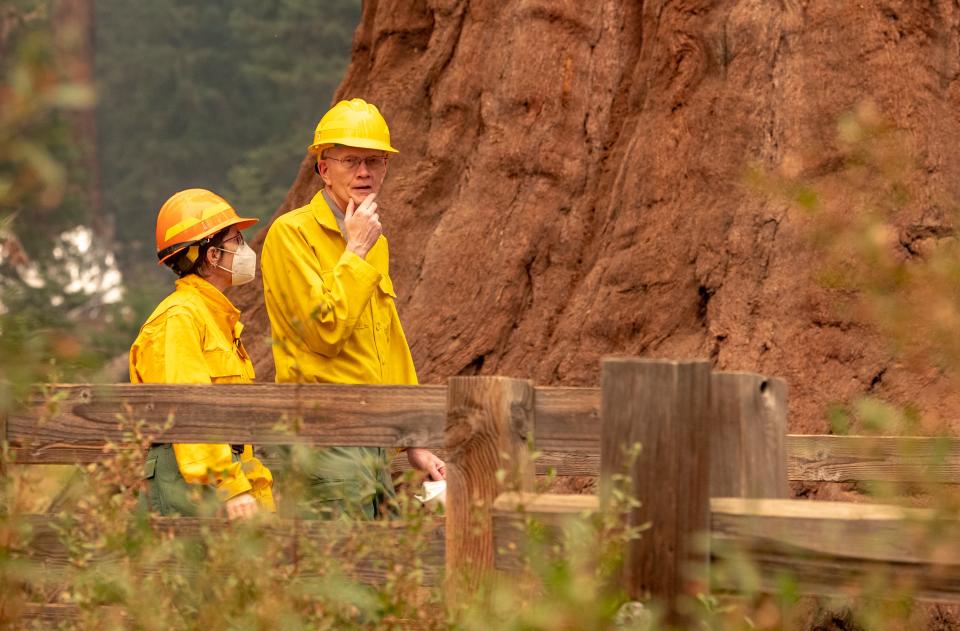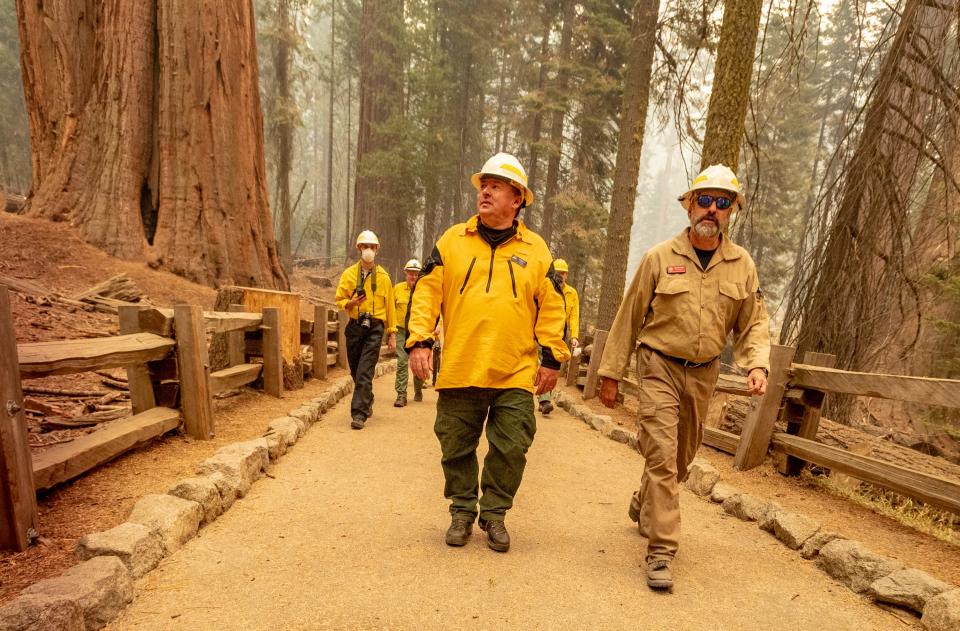California wildfire may have killed hundreds of giant sequoias, burning through Earth's largest grove
Hundreds of giant sequoias may have perished after the raging KNP Complex Fire raced through Redwood Mountain Grove, considered to be the Earth's largest, as well as the birthplace of modern prescribed burning science.
High-severity fire burned through the grove early Monday, creating its own weather — a massive fire cloud that generated 50 mph gusts and blew singed sequoia needles to nearby Hume Lake in Sequoia National Forest in California.
Scientists prepping the grove ahead of the KNP's arrival had tagged 400 sequoias as "high-risk" because of the abundance of dead trees in the area and the steep, uphill terrain – conditions that have resulted in blazes capable of mortally wounding the famed giants, experts said.
What is going on with the weather? Tackle deep climate issues and current events with the Climate Point newsletter
Aerial crews had planned to drop fire-resistant gel on the sequoias' treetops, where they are most vulnerable to flames, but the operation was scrapped after conditions became unsafe. Heat mapping performed in the days since shows the fire burned hot enough to produce the kinds of crown fires that have already killed thousands of sequoia across the southern Sierra Nevada.
The fire's run through Redwood Mountain Grove comes weeks after the KNP Complex initially sparked, just as firefighters had begun to achieve significant containment around the 130-square-mile blaze in Sequoia and Kings Canyon national parks.
"There's so much uncertainty I'm trying not to think about it," said Christy Brigham, the parks' chief scientist. "When I first saw the smoke plume, I cried heavily."

Despite some worrying signs, Brigham maintains there are reasons to be hopeful about the grove's prospects: Prescribed burning had occurred at the edge of the stand just three years ago, and photos taken from Generals Highway show mature sequoias with healthy "broccoli tops."
The Redwood Mountain Grove's fate won't be known for sure until firefighters can access the land, hopefully sometime in the next week, Brigham said.
What she does know, based on heat mapping, is that more than 80% of the massive 2,600-acre stand burned. But just because fire burned through an area doesn't mean every tree there has been killed, she added.
The KNP Complex is 85,000 acres and 11% contained, according to fire officials. Containment dropped by half after the wildfire torched the mountain grove early Monday.

Birthplace of modern prescribed fire
The Redwood Mountain Grove in California is considered the birthplace of modern fire ecology by scientists who study the role of fire on the natural landscape. Researchers used the grove as a laboratory to demonstrate the beneficial effects of controlled burning, a then-novel idea, to an audience of skeptical foresters in the 60s and 70s.
"Redwood Mountain in the western United States really became the cradle of this change and an openness to the use of fire as a natural part of the ecosystem and as a management tool," Brigham said. "For the parks service, that's where this new era of fire ecology was born."
How did the Redwood Mountain Grove, an early poster child for prescribed burning, fall victim to the very kind of unnatural, high-intensity fire that researchers had warned about decades ago?
The answer is complicated, Brigham says.
"It's not that we forgot, and it's not that there was evil intention," she said. "But all the factors have to be right to continue to have a successful prescribed fire program like we have had in Giant Forest and Grant Grove."
Prescribed fire in sequoia groves requires decades of commitment. You can't burn a grove and walk away. After an initial burn, crews must return every 15 years to maintain the groves and keep them healthy – just like a home, Brigham says.
"If your funding and staffing or public support wavers, then you miss a few. You start to accumulate fuel, and when you accumulate that fuel it becomes unsafe to do the burn," the scientist said. " Add on top of that climate change, and the tree mortality from climate change, and the second year of drought ... then your window where it's safe to do a prescribed burn goes away."
Despite those challenges, Sequoia and Kings Canyon have run one of the most successful prescribed burning programs in the country. Six burns have occurred in the Redwood Mountain Grove since 2000, continuing the legacy of her predecessors.

Adopting Native American practices
Without those prescribed fires, the KNP's impact on the historic grove would likely be much worse. As it stands, Brigham expects many parts of the grove will actually benefit from the fire.
Sequoia are among the most fire-adapted species on the planet and require low- and moderate-intensity heat to burst their pinecones and clear the forest of competitors. Research performed in Redwood Mountain showed that lightning-caused wildfires touched sequoia groves every 12 to 16 years, on average.
Watch: Scorched trees left in wake of Caldor Fire
But the giants, with their 2-foot-thick bark and crowns that tower hundreds of feet above the ground, are no match for the mega-blazes that have recently scorched the West. These fires are unlike any the Sierra has experienced in millennia; experts say they are fueled by a century of poor forest management and worsened by climate change.
Indigenous tribes that called the Sierra Nevada home long before white settlers arrived understood fire's role in the landscape and practiced cultural burning, keeping the forest healthy. Some of the earliest burns that NPS prescribed were done in collaboration with local tribes, such as the Wukchumni and Tule River.

Tribal representatives said it has taken science decades to catch up with the traditional knowledge that their ancestors had understood and put into practice for centuries.
"It's something that we carry as an honor," said Lauren McDarment, a cultural specialist with the Tule River Indian Tribe, located in the southern Sierra. "This is the landscape that we have lived with for centuries, and it needs fire to go through ... to cleanse the areas and let new life regrow."
"Not just the sequoias but the animals and the fish; they get more nutrients," he added. "Everything is healthier."
Despite the damage to the sequoia groves, which are sacred to McDarment and his people, he remains optimistic about the future. In the footprint of the 2017 Pier Fire, for example, McDarment recently saw a carpet of green needles: Hundreds of sequoia saplings.
Some of those tiny trees could be transplanted to other burned groves, where sequoia regeneration isn't happening, said Garrett Dickman, a wildfire botanist with Yosemite National Park.
He points out, though, that a baby sequoia is a far cry from the 1,000-year-old monarchs that tower above the forest canopy and inspire awe in visitors worldwide.
"On balance, we'll see more beneficial effects than negative ones but when the loss is a 1,000-year-old or 2,000-year-old tree it's hard to take," Brigham said.
Joshua Yeager covers water, agriculture, parks, and housing for the Visalia Times-Delta and Tulare Advance-Register newspapers. Follow him on Twitter @VTD_Joshy.
This article originally appeared on Visalia Times-Delta: California wildfire torches Earth's largest giant sequoia grove

